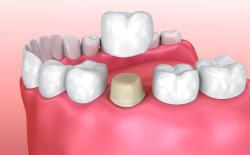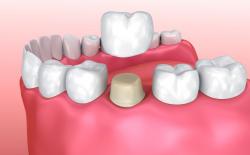What causes loose dental crowns?
Dental crowns are placed on large cavity fillings, implants or root canal treated teeth.
The crowns are glued to the prepared teeth with luting cement, which is available in various types depending on the particle size, bond strength, solubility, etc.
If under any condition, the crown does not fit snugly and is not stable, it becomes a loose crown.
These are the most common reasons that cause loose crowns:
- Microleakages: Microleakage is caused when the luting cement used to adhere the crown to the tooth structure is washed off. This creates a hollow cement space resulting in a loosened crown.
- Cavities/tooth decay: Restored teeth are more susceptible to plaque accumulation if not kept clean. Over time, this leads to tooth decay under the crown, altering the tooth structure.
- Grinding/clenching: This creates constant pressure over the teeth creating undue stresses.
- Food habits: Sticky food may pull out the crown.
- Jerk/trauma: Any type of sudden jerk while brushing, flossing and trauma due to fall or a severe blow can lead to the loosening of the crown.
- Other causes:
- Technical errors in laboratory processing of crowns, resulting in altered dimensions or distorted crown.
- The incomplete set of the cement while fixing the crown.
- Cement contamination with oral fluids creating a weaker bond between the crown and the tooth.
Top reasons why dental crowns fall off. Duration: 0:59
What are the symptoms of loose crowns?
Sometimes it is not obvious that the pain/discomfort you feel in your mouth is caused by a loose crown.
These are the most common symptoms of loose crowns:
- Discomfort and sensitivity
- Toothache
- Pain on biting
- Pain and discomfort in jaws
- Trauma to the underlying gums
- Sensitive gums
You need to consult with your dentist if you experience any of the above.
Loose temporary crowns
A temporary crown is placed after the tooth is prepared by trimming and before the permanent crown is placed.
The main purpose of the temporary crown is to maintain the structure and position of the tooth until the permanent one is placed.
In case of a loose temporary crown, you should consult with your dentist as soon as possible, because waiting for a longer period of time may alter the tooth structure and even supraeruption (i.e. your tooth emerges from the jawbone) could occur to maintain the contact with the opposing teeth.
There is also the danger of restoration fracture under the crown and even tooth fracture in extreme cases.
Restoration fracture requires rebuilding with composites and repreparation of the tooth along with the new impression of the impacted tooth.
A fractured tooth with a loose crown is commonly seen with large restorations where the natural crown bulk is less. In such cases, dental crowns with proper fit render good integrity and strength.
Loose temporary crowns may even compromise the fit and comfort of the permanent crown. So, it is always better to get your loose temporary crowns replaced or refixed to avoid any further complicated procedures.
A dentist's advice on what to do if your temporary crown falls off. Duration: 1:44
Loose permanent crowns
A loose permanent crown hampers the function of chewing associated with discomfort and pain.
Supraeruption is seen here also. If the crown had been loose for a longer period of time, the underlying tooth structure can start to degrade and makes the bulk of the tooth lesser and lesser to retain a crown properly.
It also facilitates an entry of microbes into the canal and ultimately to the bone resulting in infections at the root end (periapical infections) and gum problems (gingivitis and periodontitis)
Loose crowns may get separated completely from the tooth. This affects the overall occlusion and health of the teeth. In such conditions, drifting of adjacent teeth is seen to maintain contact among the teeth.
Loose crowns on implants
Loose tooth crowns on implants may be caused by many reasons. A few of them are mentioned below. The underlying cause must be ruled out correctly and rectified by a qualified dentist.
- The cement is washed off. This can be repaired easily by cleaning and refixing the crown.
- Abutment fracture: Abutment attaches the crown to the implant. In the case of abutment fracture, the entire abutment needs to be changed along with the crown.
- Loss of screw in screw-retained implants: In such cases, the problem can be solved by changing the screw and fixing back the same crown
- Improper screw design: Screw does not get anchored inside the bone properly resulting in less stability. Rougher surface and surface treated implants provide greater stability, therefore they are preferred.
- Other causes: Poor bone health or systemic diseases impairing bone quality. Periodontitis where the bone level is comparatively less may affect the stability of an implant. In such cases, bone grafting can be used.
A short video about loose crowns on dental implants. Duration: 0:58
How to fix a loose tooth crown?
If your crown feels loose, it must be fixed by a registered dentist only.
No attempts should be made for self-fixing. This may lead to complications and accidental engulfing of the crown too.
A dentist will properly rule out the cause of the loosening and will fix the problem accordingly.
Can a loose crown be refitted?
Yes, but not always! Only in few conditions like when the luting cement is washed off and the crown is in good condition and intact without any distortion and only if you visit your dentist immediately, in 1 or 2 days. The dentist may attempt to clean and fix it back.
However, if the tooth is decayed or degraded or if you fail to get to your dentist within a few days, a new crown might be mandatory with a new impression of the teeth taken.
How much does It cost to fix a loose crown?
Refitting a loose crown alone is charged minimally.
The cost depends on the type of crown and the type of luting cement used. The average cost ranges from $80 - $150 including the clinical oral examination.
In case an X-ray is required, an additional amount of $30 - $150 is charged.
However, if your crown cannot be refitted, you might need to buy a new crown, which might cost from several hundred to a few thousand dollars.
Frequenlty asked questions
Can I feel pain?
You may. Loose crowns may cause toothache and sensitivity, especially while chewing.
Is it a dental emergency?
It's not actually an emergency but you should consult your dentist as soon as possible to avoid complications and further complex procedures.
Is it normal for a crown to be loose? Can I eat with a loose crown?
No, it's not normal and you cannot eat with a loose crown as it reduces chewing efficiency and causes discomfort.
What kind of glue dentists use for crowns?
There are special adherents which are called luting cements . They are sticky and form a thin film between the tooth and the crown. They are strong enough to hold the crown in place while chewing.
You might also be interested in:
Dental Crown Pain
Secondary caries, infection, and loose crowns are some of the most common reasons for dental crown pain.
How Long Do Dental Crowns Last?
Dental crowns usually last for about 5-15 years, however, in certain cases they can last a lot more.
Dental Crowns Cost
The price of a dental crown depends on many factors. Read our article to find out more about what affects the cost of a dental crown.



